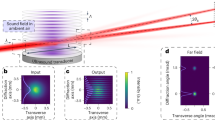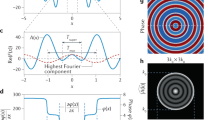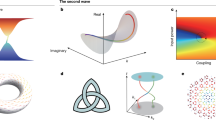Abstract
RECENTLY one of us1 pointed out that the optical diffraction effects by supersonic waves in solids are to be interpreted on the basis of the Raman-Nath2 theory, taking due cognisance of the photo-elastic effects arising from the strains caused by the sound waves. A refined further development of this idea enables us now to offer an explanation for a curious effect observed by Hiedemann and Hoesch3. Their experiments with glasses show two diffraction patterns of different spacings. With crossed Nicols normal and parallel to the sound-wave, only the pattern with the larger spacing is observed. It consists of the first orders only, with the central one missing. With the crossed Nicols at ± 45° to the sound-wave, only the pattern with the smaller spacing appears, showing many orders, including the central one.
Similar content being viewed by others
Article PDF
References
Mueller, H., Phys. Rev., 52, 223 (1937).
Raman, C. V., and Nagendra Nath, N. S., Proc. Ind. Acad. Sci., 2, 406, 413 and 3, 75, 119, 459 (1936).
Hiedemann, E., and Hoesch, K. H., Naturwiss., 24, 60 (1936).
Schaefer, Cl., and Bergmann, L., Naturwiss., 22, 685 (1934) and Sitzgsber. preuss. Akad. Wiss., 14 (1935).
Author information
Authors and Affiliations
Rights and permissions
About this article
Cite this article
NATH, N., MUELLER, H. Diffraction of Light by Supersonic Waves in Solids. Nature 141, 37 (1938). https://doi.org/10.1038/141037a0
Issue date:
DOI: https://doi.org/10.1038/141037a0
This article is cited by
-
The diffraction of light by supersonic waves
Proceedings of the Indian Academy of Sciences - Section A (1938)



